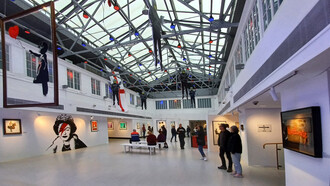Over seventy extraordinary works from prestigious public and private collections shed light on the evolution of landscape painting in Piedmont and Lombardy from the 1820s to the first decade of the 20th century. A little-known but peculiar aspect of art history, in which some of the most important artists active in Italy and Europe during that period were protagonists.
From the countryside to the high mountains, from the lakes to the sea, and on to the urban landscapes of the heart of Milan, the Navigli and the Carrobbio, METS Percorsi d'Arte brings to the Castle of Novara a theme that is always popular and a harbinger of new insights.
The first section is dedicated to the landscape of the Romantic period, represented by some of the most talented artists from the northern area. On display are examples of the different typologies of ‘village painting’, which in those years took the form of perspective views, real landscapes—taken from life, invention, and composition—and historiated landscapes. From Bergamo's Marco Gozzi (1759-1839)—a trait d'union between Neoclassical and Romantic tastes—we continue with Giovanni Migliara from Alessandria (1775-1837), Luigi Basiletti from Brescia (17801859), Giuseppe Canella from Verona (1788-1847), the Turin-born Massimo d'Azeglio (1798-1866) and the Genoese Giuseppe Bisi (1787-1869), the latter holding the first chair of landscape painting at the Brera Academy of Fine Arts, established in 1838 ad personam. The 1930s and 1940s were the years of the full affirmation of landscape painting and the great success of the ‘village painters’, year after year, exhibition after exhibition, increasingly numerous and sought after by collectors.
The second section offers space for the fundamental contributions of romantic-naturalistic landscape painting from the Central European area. The Genevan Alexandre Calame (1810-1864) and the German Julius Lange (1817-1878), who were present at exhibitions in Braid from the early 1950s, were to influence the new generation of landscape painters working in north-western Italy, such as Angelo Beccaria (1820-1897) and Gaetano Fasanotti (1831-1882), who, following the example of their foreign colleagues, began to paint on motifs and study nature from life, paving the way for future research. The section closes with Antonio Fontanesi (18181882).
As is well known, landscape has been at the center of his interests since his early years in Geneva, years in which the painter was in close contact with Calame. However, it was the encounter with the French landscape painters of the Barbizon school, first and foremost Camille Corot (1796-1875), Charles-François Daubigny (1817-1878), Théodore Rousseau (1812-1867), and Constant Troyon (1810-1865), whom he met directly when visiting the halls of the 1855 Universal Exhibition in Paris, that persuaded Fontanesi to continue his research by working en plein air in the very places that had seen the birth of some of those masterpieces.
In addition to Fontanesi and the Genoese Tammar Luxoro (1825-1899), one of the founders of the Genoa Society for the Promotion of Fine Arts in 1849, Alexandre Calame and his prestigious school attracted most of the young landscape painters. Apart from Carlo Pittara (1835-1891), who moved to Geneva and perfected his skills by attending the studio of the animal painter Charles Humbert (1813-1881), for the new generation of landscape painters, Geneva was Calame's school. Among the first to follow his lessons were the Turinese Vittorio Avondo (1836-1910), the Portuguese Alfredo de Andrade (1839-1915), the Spaniard Serafin de Avendaño (1838-1916), and the Genoese Ernesto Rayper (1840-1873).
Meetings, friendships, friendships that would strengthen at the tables of the café du Bourg, a place also favored by Ernesto Bertea (1836-1904), Gustave Castan (1823-1892), and Fontanesi himself, and which would be fundamental for the subsequent realist experiences, those known today by the names of the locations where the artists would gather to paint on the motif: Rivara, in the Canavese area, where the painters would be hosted at Villa Ogliani, the residence of Carlo Ogliani, Carlo Pittara's brother-in-law, and Carcare, in the province of Savona, where the ‘Ligurians’ de Avendaño, de Andrade, and Rayper would give life to the ‘Scuola dei Grigi’.
From the first half of the 1870s, the landscape became the privileged place for confronting reality, even for a painter of genre scenes as Filippo Carcano (1840–1914) had been considered until then; around this time, he would go on to work en plein air with Eugenio Gignous (1850–1906) in the Lombard lakes, around Stresa, on the heights of Mottarone, trying to develop a new language that could best represent ‘the impression of reality'.
Starting precisely with Carcano—from the early 1980s recognized as the leader of Lombard Naturalism—the section presents some of the most significant works by Eugenio Gignous, Leonardo Bazzaro (1853-1937), Achille Befani Formis (1832-1906), Pompeo Mariani (1857-1927), Francesco Filippini (1853-1895), Lorenzo Delleani (1840-1908), and other artists—works that also appropriately document the life, habits, and customs of the people who lived in those ‘landscapes’ or frequented them as tourist destinations.
The room is dedicated to some views of the Milanese urban landscape, captured in full sun and snow by Giovanni Segantini (1858-1899), Mosè Bianchi (1840-1904), and Emilio Gola (1851-1923) from the early 1980s to the early 1990s.
The room presents a number of paintings executed in the 1990s: these include Lorenzo Delleani's vast canvas of Lago del Mucrone (1890); two extraordinary paintings by the now very famous Filippo Carcano, Dall'alto (1895) and Il ghiacciaio di Cambrena (1897); and a canvas by the very young Ludovico Cavaleri (1867-1942), Dalle montagne del lago maggiore (1898).
The last section of the exhibition is dedicated to the works of artists who worked in the Divisionist sphere, such as Giovanni Segantini (1858-1899), Angelo Morbelli (1853-1919), Giuseppe Pellizza (1868-1907), Emilio Longoni (1859-1932), and Carlo Fornara (1871-1968), for some of whom the landscape became the privileged subject not only of linguistic experimentation but also the ideal place for some forays into the Symbolist climate.















